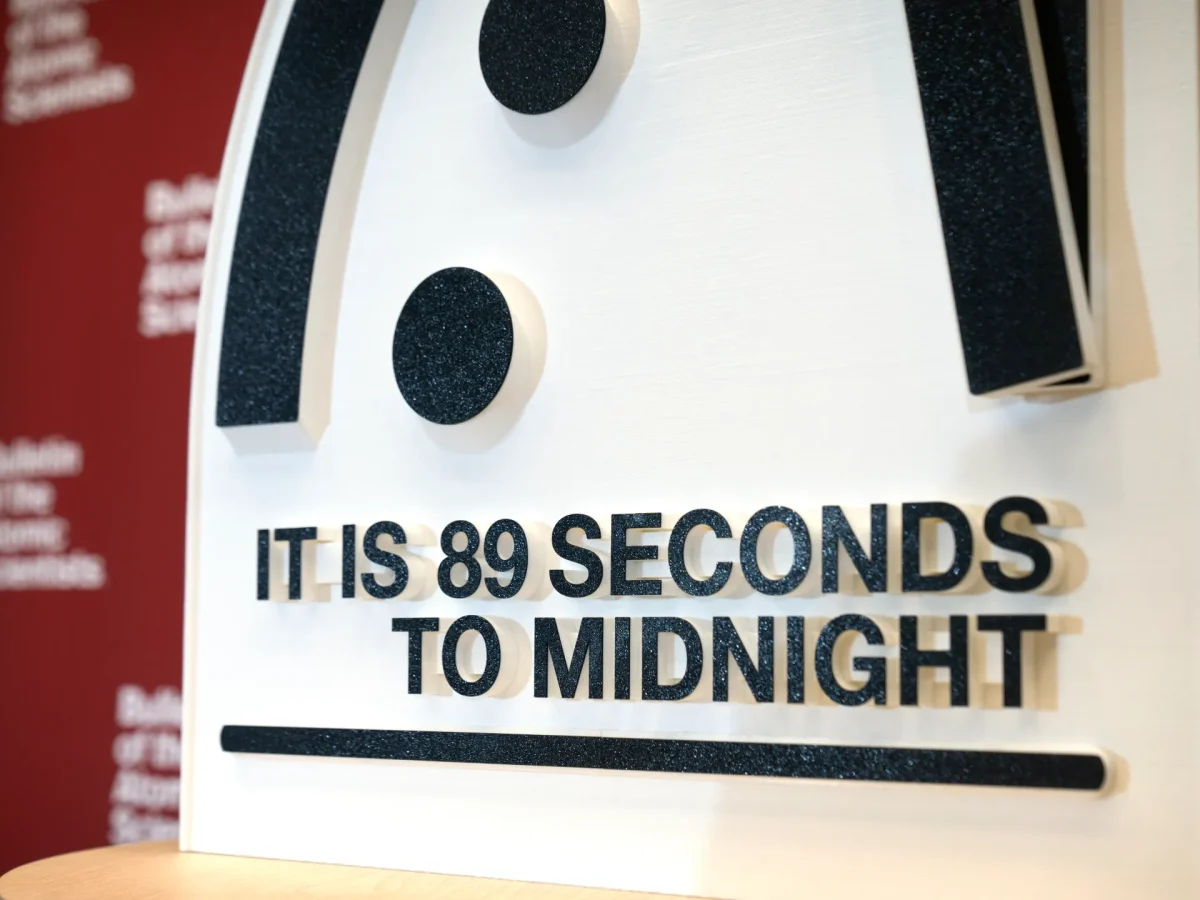At 89 seconds to midnight, The Doomsday Clock is signifying that humanity is now closer than ever to catastrophe.
Created by the Bulletin of Atomic Scientists, The Doomsday Clock is a visual representation of humanity’s steady decline toward a man-made global disaster. It is important to note that The Doomsday Clock is strictly a metaphor and should not be used as a means of prediction and that the time on the clock should not be interpreted as actual time. Factors like nuclear war threats, climate change, and the development of potentially dangerous technologies control which direction the clock ticks. But what does it mean?
The Doomsday Clock can be traced back to a group of scientists called the Chicago Atomic Scientists who had been participants in the Manhattan Project following the atomic bombings of Hiroshima and Nagasaki in 1945. They began publishing a newsletter and shortly after, a magazine, called the Bulletin of Atomic Scientists. Each magazine cover featured a clock that was not officially referred to as “The Doomsday Clock” until 1947. Eugene Rabinowitch, a co-founder of the Bulletin, explained the clock to be “not a gauge to register the ups and downs of the international power struggle,” rather, “it is intended to reflect changes in the level of continuous danger in which mankind lives in the nuclear age.” The Doomsday Clock is updated annually, in a day-long conference called The Doomsday Symposium. The clock’s hands have been adjusted 25 times since its creation in 1947 when it had been set to 7 minutes until midnight.
“Midnight” has a variation of different meanings in the context of what is going on in the world at any given time. Elements such as politics, energy, weapons, diplomacy, and climate change are all taken into consideration when charting humanity’s closeness to midnight.
The fluctuation in our closeness to midnight is inconsistent and can change each year. Before 2020, the closest we had ever been to midnight was in 1953 when the clock had been set to two minutes until midnight following the U.S and Soviet Union beginning to test hydrogen bombs. Its lowest was 17 minutes to midnight in 1991 after the Cold War had officially ended and the U.S and Russia began to make deep cuts within their nuclear arsenals. But since then, we have had several midnight scares, like in 2017, when the clock had been set to two minutes and 30 seconds due to the nuclear war moves by Kim Jong-un and the Trump Administration. It remained unchanged until 2019.
In 2024, the clock was set to 90 seconds until midnight. Many believed that that was the closest we’d ever get and that we could only go up from there. Unfortunately, we were wrong.
On Jan. 28, 2025, the Science and Security Board and Bulletin of Atomic Scientists released an official statement titled “Closer than ever: It is now 89 seconds to midnight.” In moving the clock’s hands one second closer to midnight the Bulletin sends a stark and clear message that we can no longer ignore or deny the clear dangers of humanities’ actions. Every second we delay to make positive change, we increase our likelihood for disaster.
The Bulletin lists several current threats that are pushing us toward midnight. War, climate change, bioterrorism, and disruptive technologies such as AI are the biggest contenders.
In regards to war, the conflict between Ukraine and Russia is now in its third year and holds the potential threat of becoming nuclear at any moment due to rash decisions being made by Prime Minister Zelensky and Presidents Putin and Trump. Moreover, the conflict in the Middle East continues to spiral out of control, with the possibility of becoming a wider war without any warning. Countries with possession of nuclear weapons continue to develop their arsenals, investing hundreds and thousands of dollars into destructive weaponry.
The threat of climate change increased all throughout last year with rise in sea-level, global rise in greenhouse gasses, and an increase in global surface temperature which surpassed previous records. Climate change has influenced extreme weather events such as floods, tropical cyclones, heat waves, droughts, and wildfires. “The long-term prognosis for the world’s attempts to deal with climate change remains poor, as most governments fail to enact the financing and policy initiatives necessary to halt global warming,” said John Mecklin, editor of the Bulletin’s official Doomsday Clock statement.
Biological threats like re-emergence of viral diseases continue to pose threats to humanity. The most concerning is the off-season appearance and in-season increases in influenza, which has begun to spread to farm animals, infecting various livestock and dairy products. With climate change affecting the speed in which the ice caps melt, dangerous pathogens with the potential to create devastating pandemics have the increased risk of escaping.
The Bulletin’s statement points out the neglect from world leaders to take these threats seriously. “Despite unmistakable signs of danger, national leaders and their societies have failed to do what was needed to change course. Consequently, we now move The Doomsday Clock from 90 seconds to 89 seconds to midnight–the closest it has ever been to catastrophe.” Stating that blindly continuing on the current path we sit on is madness. Global powers such as The United States, China, and Russia all have the collective power to greatly destroy society and thus hold the responsibility to pull the world back and bring us away from the brink. And it can be done. Change is possible and it can only happen if our leaders work toward serious good-faith decisions and turn their attention toward the prosperity of society. We are not doomed, but the world needs immediate action to right the wrongs that were set in motion in 2020.
“It is 89 seconds to midnight.”


